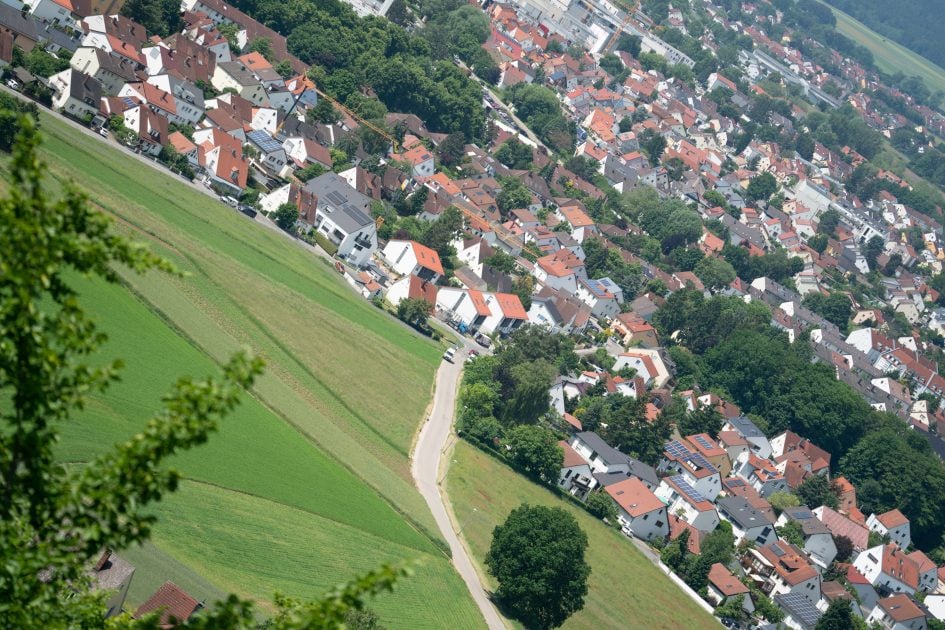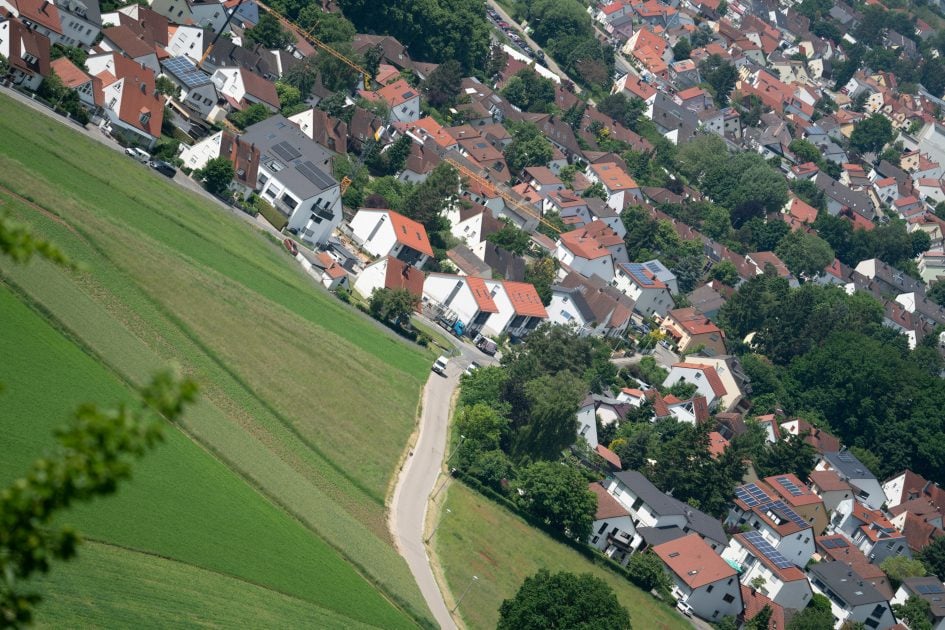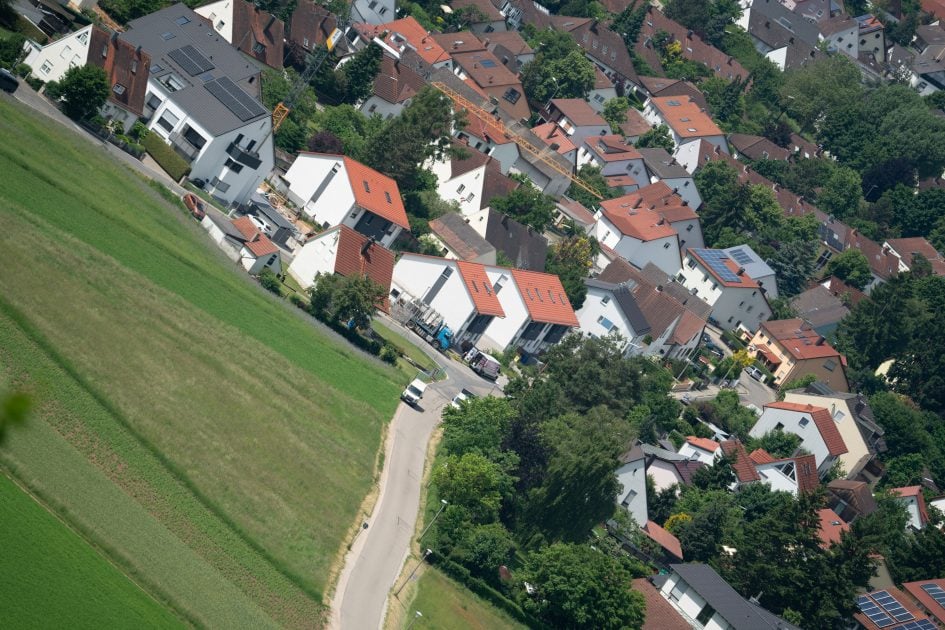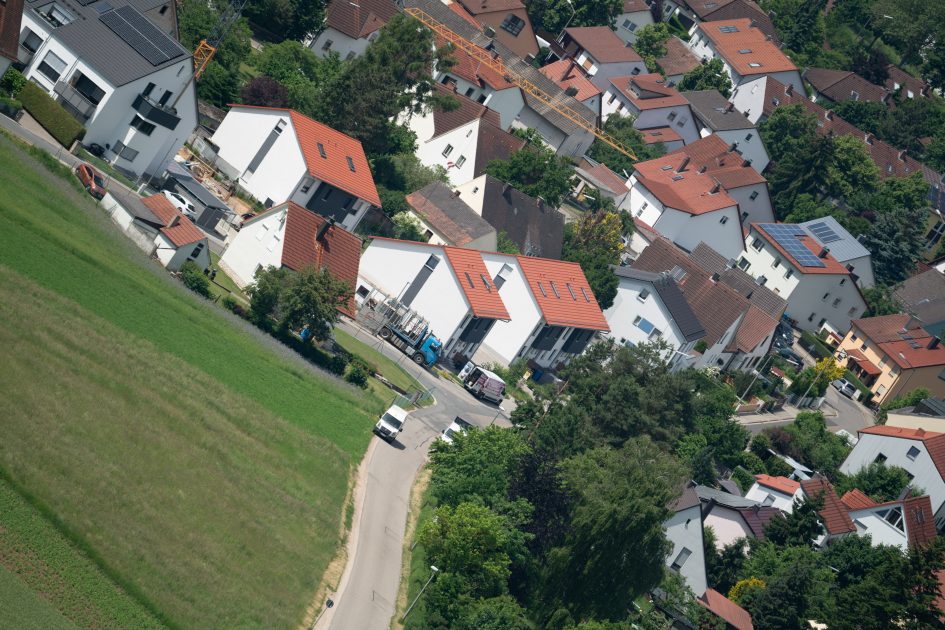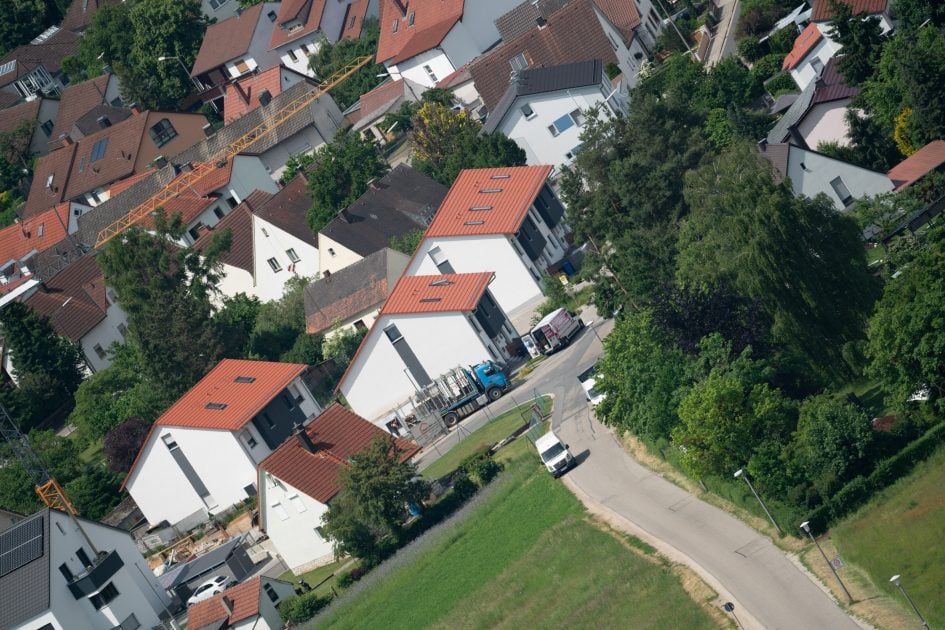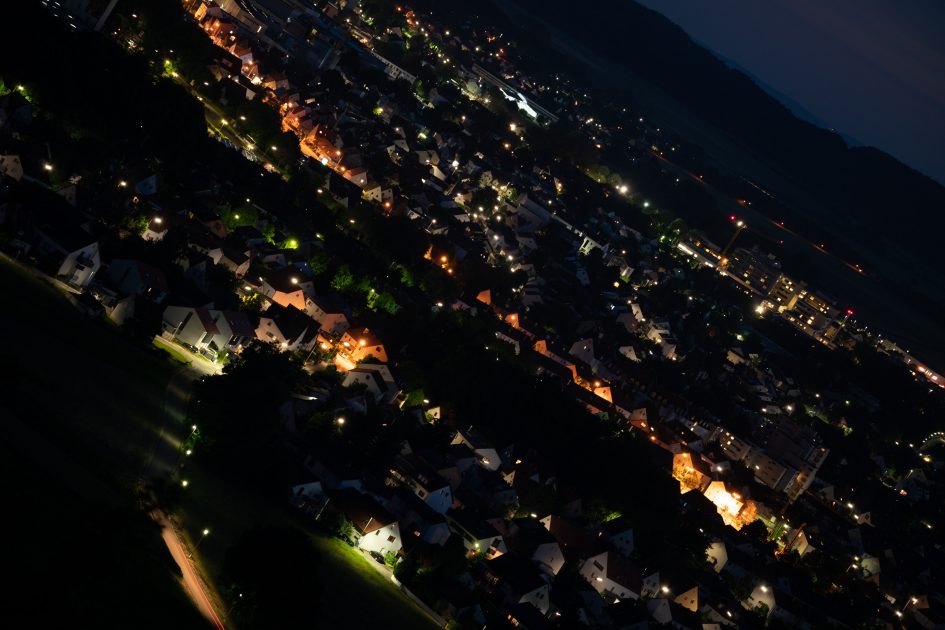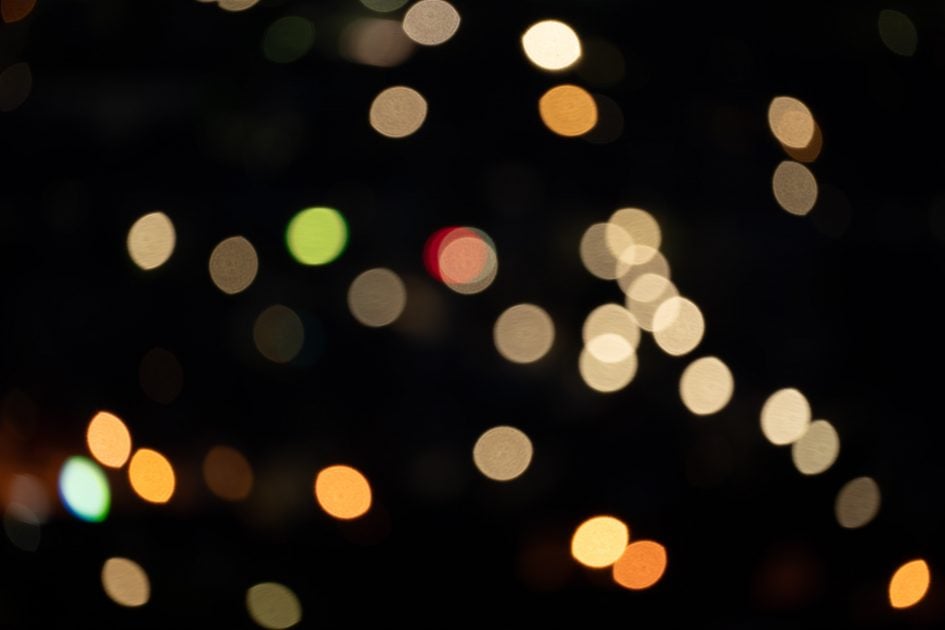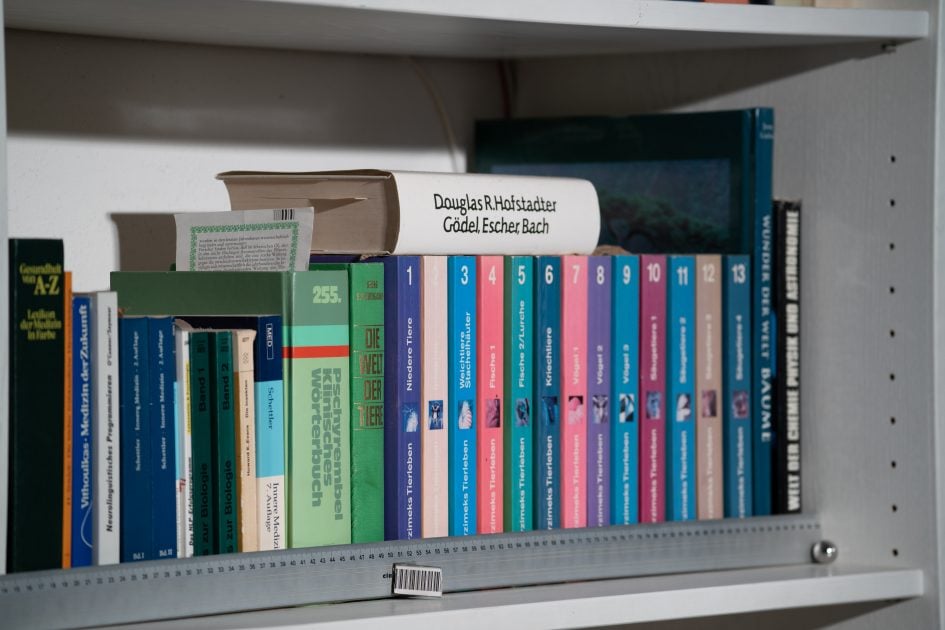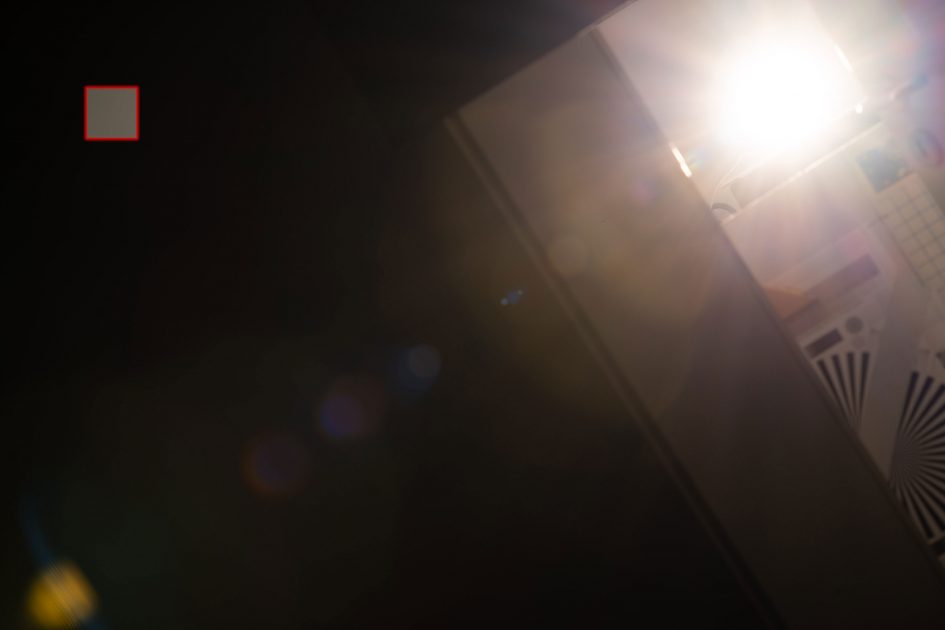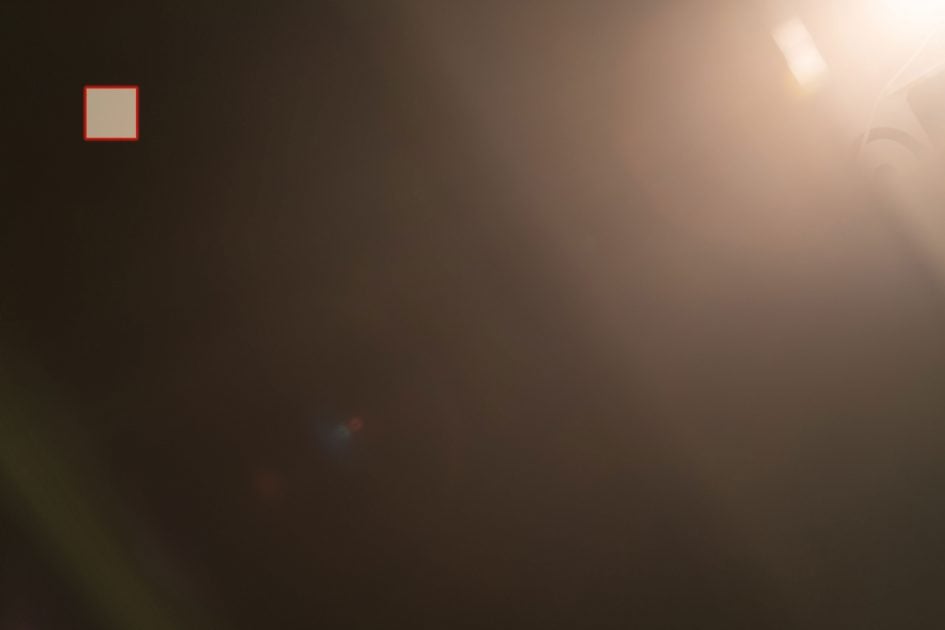Tamron 150-500mm f5-6.7 Di III VC review
-
-
Written by Thomas
Quality
Testing: Longitudinal Chromatic Aberration and focus shift
Lenses with focal ratios of f2.8 or larger are often prone to longitudinal color aberrations (loCA, a.k.a. “axial color” or “bokeh CA”). These normally show up as magenta coloration in the foreground and greenish hues in the background and are not easily corrected in post-processing. The new Tamron has very little loCA but there’s a clear focus shift to the background when the lens is stopped down to f8.0.
Tamron 150-500mm f5-6.7 Di III VC Longitudinal Chromatic Aberration (loCA)
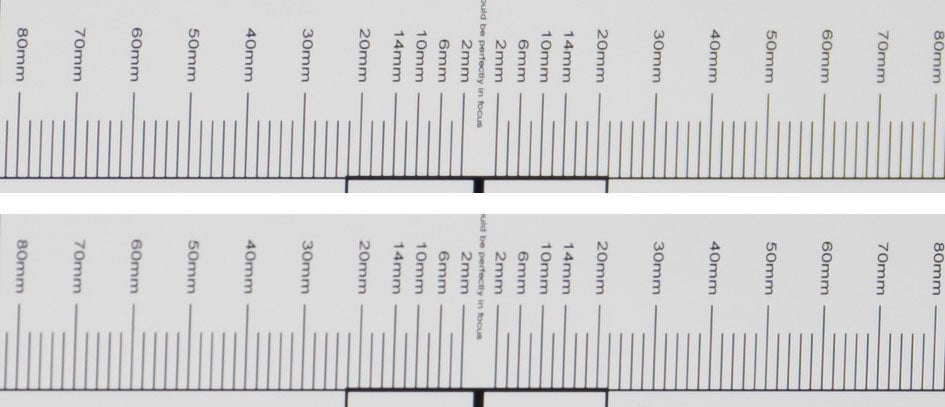
100% crops at 263mm f5.6 (top), f8.0 (bottom); left = foreground, right = background
The following 100% crop from a real life shot shows that the Tamron 150-500mm f5-6.7 Di III VC produces quite some glare but no purple fringing around high-contrast edges in the focal plane or green outlining around background subjects. The blueish coloration of the glare in the shot has more to do with the white balance.
Above: Tamron 150-500mm f5-6.7 Di III VC at 150mm f5.0, 100% crop, click image for 4k version, here for large original
Sharpness and contrast
Let’s have a look at the theoretical performance of the new Tamron 150-500mm f5-6.7 Di III VC and compare it to some other lenses:
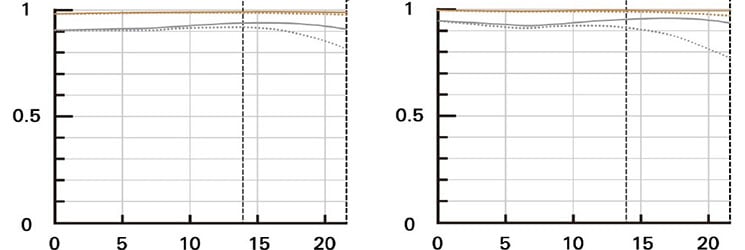
Above: Tamron 150-500mm f5-6.7 Di III VC, 150mm f5.0 (left), 500mm f6.7 (right)
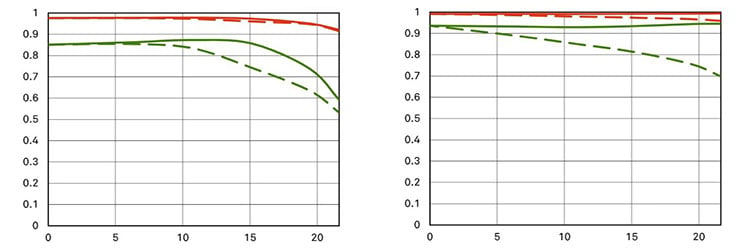
Above: Sigma 100-400mm f5-6.3 DG DN OS, 100mm f5.0 (left), 400mm f6.3 (right)
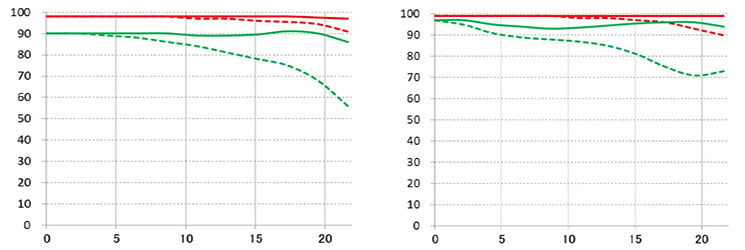
Above: Sony FE 100-400mm f4.5-5.6 GM OSS, 100mm f4.5 (left), 400mm f5.6 (right)
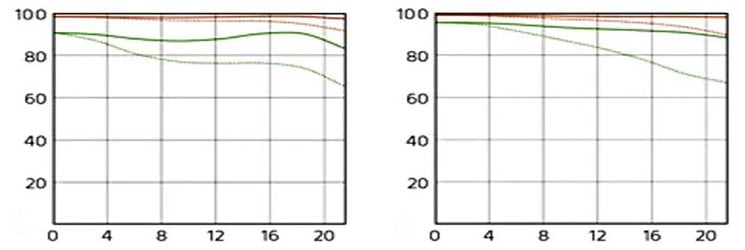
Above: Sony FE 200-600mm f5.6-6.3 G OSS, 200mm f5.6 (left), 600mm f6.3 (right)
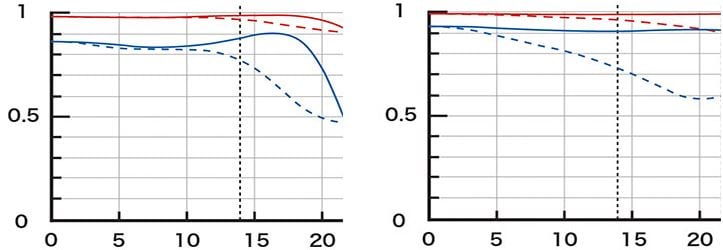
Above: Tamron 150-600mm f5-6.3 Di VC G2, 150mm f5.0 (left), 600mm f6.3 (right)
These MTF charts show the computed lens-performance of lenses wide open without influence of diffraction at 10 line-pairs/mm (red) and 30 lp/mm (blue/green). Higher values are better (more contrast) and the closer the dotted and solid lines are together the less contrast dependents on the orientation of the test-pattern (less astigmatism). The x-axis displays the distance from the optical axis (=center of the sensor) in mm.
The Tamron 150-500mm f5-6.7 Di III VC looks very good in these charts – both on the long end and the short end: Sharpness is very high right up into the extreme corners with only little astigmatism. This makes the Tamron 150-500 look even better (on paper) than the Sony FE 100-400mm f4.5-5.6 GM OSS which is well known for its excellent performance.
Let’s see how this theoretical performance translates into real life results in the sharpness test based on Siemens-stars. Processing was done in Lightroom 9.3/CRAW 12.3 from RAW to Adobe Color profile with the built-in lens profile for CA and vignette compensation applied. Noise-reduction is set to 0, sharpening to 50/0.5/36/10, with no extra tone, color, or saturation adjustment. White-balance was adjusted to a neutral white and I did some exposure compensation to make the brightness of all crops match. So you will not see light fall-off in the corners.
The following are all 100% crops!
First up is an overview of the wide-open performance at different focal lengths. You can jump to the detailed results at different apertures by clicking on the crops of the respective focal length.
Tamron 150-500mm f5-6.7 Di III VC; 100% crop from center, APS-C-corner, FF-corner
Above: 150mm, f5.0
Above: 200mm, f5.0
Above: 300mm, f5.6
Above: 400mm, f6.3
Above: 500mm, f6.7
Tamron’s new zoom lens performs nicely up to 300mm focal length across the high resolution full-frame sensor. At 400mm and 500mm results become a bit softer but with some additional sharpening you’ll still get a lot of details. The test also revealed that the lens has some field curvature and the issue of focus shift forced me to refocus when I stopped down to f8.0 regardless of focal length.
The following 100% crops for each focal length show the Tamron 150-500mm f5-6.7 Di III VC from wide open down to f11. Or you can fast-forward to the performance at long distances.
Performance at 150mm:
Tamron 150-500mm f5-6.7 Di III VC at 150mm; 100% crop from center, APS-C-corner, FF-corner

Above: Tamron 150-500mm f5-6.7 Di III VC at 150mm, f5.0

Above: Tamron 150-500mm f5-6.7 Di III VC at 150mm, f5.6

Above: Tamron 150-500mm f5-6.7 Di III VC at 150mm, f8.0; also available at f11
Performance at 200mm:
Tamron 150-500mm f5-6.7 Di III VC at 200mm; 100% crop from center, APS-C-corner, FF-corner

Above: Tamron 150-500mm f5-6.7 Di III VC at 200mm, f5.0

Above: Tamron 150-500mm f5-6.7 Di III VC at 200mm, f5.6

Above: Tamron 150-500mm f5-6.7 Di III VC at 200mm, f8.0; also available at f11
Performance at 300mm:
Tamron 150-500mm f5-6.7 Di III VC at 300mm; 100% crop from center, APS-C-corner, FF-corner

Above: Tamron 150-500mm f5-6.7 Di III VC at 300mm, f5.6

Above: Tamron 150-500mm f5-6.7 Di III VC at 300mm, f8.0

Above: Tamron 150-500mm f5-6.7 Di III VC at 300mm, f11
Performance at 400mm:
Tamron 150-500mm f5-6.7 Di III VC at 400mm; 100% crop from center, APS-C-corner, FF-corner

Above: Tamron 150-500mm f5-6.7 Di III VC at 400mm, f6.3

Above: Tamron 150-500mm f5-6.7 Di III VC at 400mm, f8.0

Above: Tamron 150-500mm f5-6.7 Di III VC at 400mm, f11
Performance at 500mm:
Tamron 150-500mm f5-6.7 Di III VC at 500mm; 100% crop from center, APS-C-corner, FF-corner

Above: Tamron 150-500mm f5-6.7 Di III VC at 500mm, f6.7

Above: Tamron 150-500mm f5-6.7 Di III VC at 500mm, f8.0

Above: Tamron 150-500mm f5-6.7 Di III VC at 500mm, f11
Tamron’s 150-500mm f5-6.7 Di III VC zoom lens profits visibly from stopping down to f8.0.
Performance at long distances
The Siemens-star test-targets are shot at a distance of 45x focal length (i.e. at around 9m for 200mm focal length). But performance of lenses also depends on the shooting distance. Therefore I present another series of test-shots of a city around 1 km away. Processing was done in Lightroom 9.3/CRAW 12.3 from RAW to Adobe Color profile with the built-in lens profile compensating CA and vignetting. Noise-reduction is set to 0, sharpening to 50/0.5/36/10, with no extra tone, color, or saturation adjustment. All shots were made from a heavy tripod with image stabilization switched off. ISO was set to 200 to keep shutter speeds around 1/1000. So shake is definitely not an issue but heat shimmer is introducing some blur to the images – which is hard to avoid on hot sunny days. As usual I have selected the diagonal that provided the better corner results as the lens was a bit decentered.
The following images show the complete scene wide open to give you an impression of the angle of view. Following each main image are 100% crops from the center, APS-C-corner, and FF-corner. You can access the large originals but please respect our copyright and only use those images for personal use.
Tamron 150-500mm f5-6.7 Di III VC; 100% crop from center, APS-C-corner, FF-corner
Above: Tamron 150-500mm f5-6.7 Di III VC at 150mm, f5.0; click image for 4k version, here for large original
Above: Tamron 150-500mm f5-6.7 Di III VC at 200mm, f5.0; click image for 4k version, here for large original
Above: Tamron 150-500mm f5-6.7 Di III VC at 300mm, f5.6; click image for 4k version, here for large original
Above: Tamron 150-500mm f5-6.7 Di III VC at 400mm, f6.3; click image for 4k version, here for large original
Above: Tamron 150-500mm f5-6.7 Di III VC at 500mm, f6.7; click image for 4k version, here for large original
The Tamron 150-500mm f5-6.7 Di III VC again performed very well in this long-distance test: Up to 300mm focal length the lens produces sharp results right into the corner of the full-frame sensor. At 400mm and 500mm results are a bit harder to judge due to heat shimmer. But the lens still looks good.
Vignetting and distortions
To make it easier to see light fall-off in the corners of a full-frame sensor I’ve arranged a series of three shots each with the Tamron 150-500mm f5-6.7 Di III VC from f5.0 to f8.0 at 150mm and f6.7-f11 at 500mm focal length. All images were developed to the same brightness in the center and with the built-in lens profile compensating vignetting:
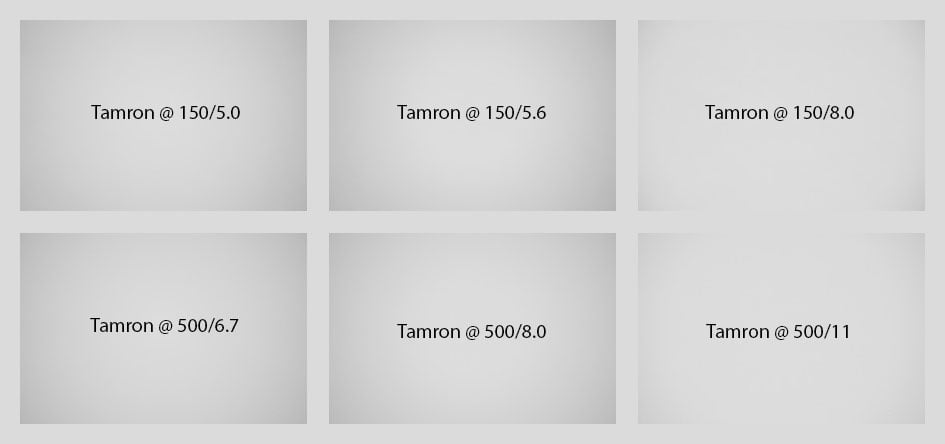
Above: Tamron 150-500mm f5-6.7 Di III VC at 150mm and 500mm focal length; shading compensation = Auto
The sample images above show that with the lens profile applied vignetting is very mild. At 150mm f5.0 automatic shading compensation lifts the extreme corners about 0.8 EV, at 500mm by about 0.7 EV. Adobe’s RAW converter automatically applies shading compensation as it was set in camera – but you cannot alter the setting in postprocessing.
Distortions are of pin-cushion type at every focal length. The setting for distortion compensation in camera is currently ignored by Adobe’s RAW converter and treated as OFF but there is a lens profile for the new Tamron in Lightroom 10.3 / CRAW 13.3. If you activate Adobe’s lens profile just dial vignetting compensation back if you already had shading compensation in camera set to Auto. The following composite images show a roof rail at the upper border of the full-frame image at various focal lengths first without distortion compensation and then with compensation from the supplied lens profile switched on:
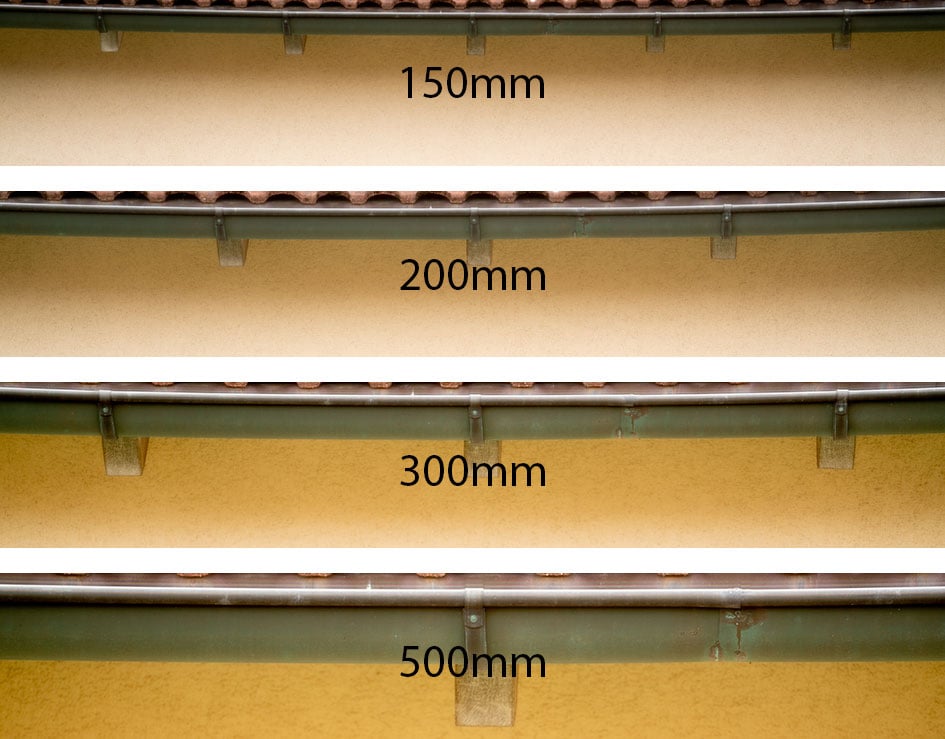
Distortions: Tamron 150-500mm f5-6.7 Di III VC at 150/200/300/500mm, distortion compensation Off
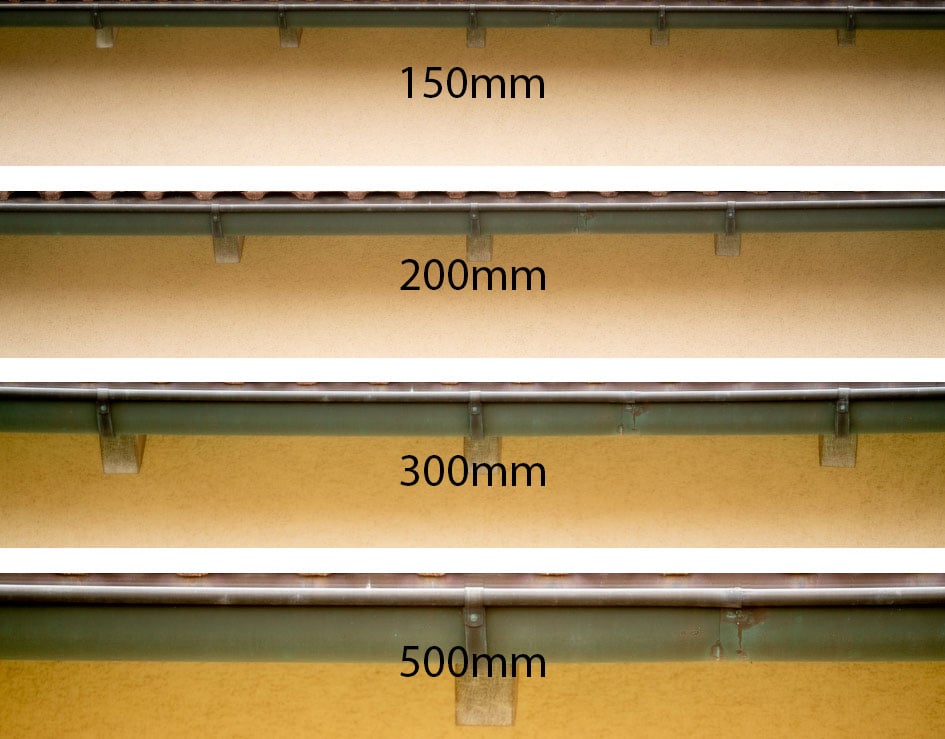
Distortions: Tamron 150-500mm f5-6.7 Di III VC at 150/200/300/500mm, distortion compensation On
As you can see there is still some distortion left even after compensation – especially at 300mm.
Rendering of point-light sources at night-shots
Night-shots pose a different challenge for lenses as the contrast is even higher than under bright sun and point-light sources can reveal some weaknesses such as coma, haloing and colour-aberrations that do not show up as prominently in other test-shots. The 100% crops below the main image show the effect of coma in the FF-corner of the Tamron 150-500mm f5-6.7 Di III VC:
Above: Tamron 150-500mm f5-6.7 Di III VC at 150mm, f5.0; click image for 4k version, here for large original

Above: Tamron 150-500mm f5-6.7 Di III VC at 150mm; 100% crops from the FF-border at f5.0 (left), f5.6 (middle), f8.0 (right)
The lens is practically free of coma and it does not show colored haloes around bright lights.
Bokeh quality
This test is for the rendering of point-light sources in an out-of-focus background. The circle of confusion that is produced by this test is pretty indicative of Bokeh performance (in the background) and light fall-off. Ideally the out-of-focus image of the point-light is evenly lit and perfectly circular, with no “onion-rings”, and without coloration. There’s also an effect known as “cat’s eye” the further away from the optical axis the point-light is projected. This is due to optical vignetting in the lens barrel when light enters the lens from an angle.
The images were shot at the longest focal length. Crops are from the center, APS-C-corner, and FF-corner resized to make them comparable across all my reviews.
Above: Tamron 150-500mm f5-6.7 Di III VC at 500mm, f6.7
Above: Tamron 150-500mm f5-6.7 Di III VC at 500mm, f6.7; click image for 4k version

Above: Tamron 150-500mm f5-6.7 Di III VC at 500mm, f8.0

Above: Tamron 150-500mm f5-6.7 Di III VC at 500mm, f11
The diameter of the Bokeh balls in the center is determined by the entrance pupil of the lens which is 75mm for the Tamron 150-500, 63mm for the Sigma 100-400, 71mm for the Sony 100-400, and 95mm for both the Sony 200-600 and Tamron 150-600 (at their respective longest focal length and largest aperture). So the longer lenses have the advantage here. The Bokeh balls from Tamron’s 150-500mm f5-6.7 Di III VC are free of onion-rings but show some outlining which becomes stronger in the center when stopped down – but shows no coloration from loCA. Compression of the circle towards the corners is clearly visible and could lead to “swirly Bokeh” especially since you’d want to use this lens wide open.
Now let’s see how this analysis of out-of-focus point-light sources translates into Bokeh-performance shooting a book-shelf. Crops are from the foreground, middle-ground, and background resized to make them comparable across all my reviews. I used the longest focal length that I could to produce a comparable shot to my other reviews which was in the case of the new Tamron 171mm.
Above: Tamron 150-500mm f5-6.7 Di III VC at 171mm, f5.0
Above: Tamron 150-500mm f5-6.7 Di III VC at 171mm, f5.0; click image for 4k version, here for large original
Bokeh is not very pronounced with these settings. It looks nervous in the foreground but shows a smooth transition zone free of color artifacts or double contours (see below). The background looks smooth. Some of the images on the following samples page clearly show a nice background Bokeh when shooting at closer distances.
Above: Tamron 150-500mm f5-6.7 Di III VC at 171mm, f5.0; 100% crop; click image for 4k version, here for large original
Close-up performance
The Tamron 150-500mm f5-6.7 Di III VC achieves a pretty decent magnification of around 1:3 (depending on focal length) in close-up shooting. The following images were shot at 1:4 magnification where the area of sharp focus is just 144 x 96mm. The crops shown below are from 0mm, 13mm, and 18mm off the center of the sensor respectively. The first set was shot at 150mm focal length, the second set at 500mm.

Above: Tamron 150-500mm f5-6.7 Di III VC at 150mm, f5.0; 100% crops

Above: Tamron 150-500mm f5-6.7 Di III VC at 150mm, f8.0; 100% crops

Above: Tamron 150-500mm f5-6.7 Di III VC at 150mm, f11; 100% crops
The lens is pretty sharp in the center even wide open. But for a larger area of good sharpness you need to stop down to at least f11. Sharpness is strongly effected by field-curvature so you could achieve sharper results outside the center by specifically focusing there. See the following example shot at f11, where the crops at 13mm and 18mm image height were separately focused. This is better but still not very satisfying:

Above: Tamron 150-500mm f5-6.7 Di III VC at 150mm, f11; 100% crops
Using the lens at 500mm focal length produces much better results outside the center with only little field-curvature. The following images were also shot at 1:4 magnification with crops from 0mm, 13mm, and 18mm off the center of the sensor respectively:

Above: Tamron 150-500mm f5-6.7 Di III VC at 500mm, f6.7; 100% crops

Above: Tamron 150-500mm f5-6.7 Di III VC at 500mm, f8.0; 100% crops

Above: Tamron 150-500mm f5-6.7 Di III VC at 500mm, f11; 100% crops
Flare, ghosting, and sun-stars
Catching a strong light-source shining directly into the lens is always a risky business: it could produce strange colorful ghost-images or reduce contrast considerably through flare and glare. The appearance of flare and ghosting depends on factors like the aperture and the angle of the light hitting the lens. So to judge the proclivity of the new Tamron 150-500mm f5-6.7 Di III VC for these artifacts I went through a series of well calculated shots against a strong light source to provoke glare and ghosting. The lens hood was mounted in all shots. Following are just two examples at different apertures and focal lengths. The little bright square inset in the upper left shows the respective area with an exposure compensation of +3 EV to make it easier to see which levels of black the lens renders at that point:
Above: Strong light hitting the Tamron 150-500mm f5-6.7 Di III VC at 150mm, f11; click image for 4k version or here for +3 EV exposure compensation
Above: Strong light hitting the Tamron 150-500mm f5-6.7 Di III VC at 290mm, f5.6; click image for 4k version or here for +3 EV exposure compensation
The Tamron 150-500mm f5-6.7 Di III VC produces some ghosting artifacts and overall contrast is considerably reduced through veiling glare when the light source is within the full-frame image-circle. Sunstars start to form at f5.6 but even when stopping down they are not very well defined:

Above: Sunstars from the Tamron 150-500mm f5-6.7 Di III VC at 150mm, f5.6 (left), f8.0 (right), 100% crops
Next check out my sample images!
Check prices on the Tamron 150-500mm f/5-6.7 Di III VXD at B&H, Adorama, WEX UK or Calumet.de. Alternatively get yourself a copy of my In Camera book or treat me to a coffee! Thanks!
